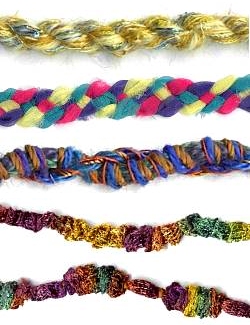Cords and Braids
Cords and braids can be made in so many ways, simply by plaiting, twisting and knotting by hand or by using ever increasingly sophisticated gadgets to assist.
Hand-made CordsHere are samples of four types of handmade cords:
|

|
LucetThe lucet has been in use for more than 1000 years. It has been used through the ages to make a square knotted cord with low stretch and good strength characteristics. |

|
CordtwisterThese simple twisted cords were made on the Anna Crutchley cordtwister. A cordtwister has the advantage over hand-made twisted cord in that it may have more than two warp threads and can be made infinitely longer. The samples show one 'S' cord (top) where the warp threads are twisted clockwise, and one 'Z' cord. Here the warp threads consist of 'S' cords which have been twisted anticlockwise to make a new cord. |

|
MarudaiThe marudai (round stand) is used in Japanese braiding (Kumihimo) the following sample shows a simple round cord which is then used as one of the strands of a second flat braid. |


|
Machine-made CordsThe first of these machine made cords has been made by wrapping a strip of stitched fabric around a hand made cord and binding with a metallic thread in places. The second is made by stitching over lengths of different threads using a one step zigzag with the feed dog up. The third is a braid, made by stitching a number of pieces of the second cord together with a three-step zigzag, it is using the three-step stitch that makes the braid flat rather than a fat round cord. |



|
« back to Decorative Techniques page | « back to City & Guilds page | ^ top